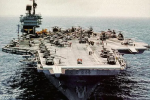NJROTC-CC
5-Year Member
- Joined
- May 6, 2019
- Messages
- 2,574

US Navy aircraft carriers may be useless in a war with China
"The days of the carrier on the modern battlefield may be numbered.”

In his memoir, Khrushchev Remembers, he goes on at some length about this very thing. “Why build these large lumbering vessels? Let’s just build a lot more missiles.”Pundits have been predicting the demise of carriers since the nuclear weapon was developed.... but they've seen plenty of use since then.
And they can transport the U.S. Army, too, as they did in Haiti during the early 90’s. Look at that flight deck! Nothing but Army helicopters (check that - I see a Navy H-60). No need for arresting gear. The Air Department must have been going crazy taking the Chinooks (CH-47s) and H-60s aboard. Re-spotting (rearraigning) the flight deck might have been a challenge initially, but I know they figured it out. Some trivia here. Notice all the Army H-60 and CH-47s are “palm tree’d”, i.e. the rotors are spread. Army helos don’t have blade fold capability. This takes up valuable flight deck and hangar deck space. Navy H-60s and H-53Es all have blade fold capability. It is a Navy requirement for operating at sea. On the transit, you can bet that ship's company sailors had some good fun at the soldier’s expense, like manning the mail buoy watch and catching and showing off a sea bat for the first time.In modern times, our aircraft carriers have had a lot of utility as mobile technology to help areas hit by natural and man-made disasters.
The fact that they can provide enough power to supply a city (or even a small island nation) with electricity and clean drinking water is impressive enough on its own. They also bring with them a modern hospital with its own imaging department, a testing laboratory, emergency room, intensive care, operating rooms, and a 41-bed hospital. This all comes staffed by 5 doctors, 6 nurses, and 30 corpsmen.
And can they fix stuff !
They have machinists, plumbers, HVAC technicians, electricians, and a host of other high-trained folks who can fix almost anything.
Here's an interesting article about technicians who can rewind electric motors on board: https://www.dvidshub.net/news/371913/fords-motor-rewind-ships-repair-capability
Sure, the USS Gerald R. Ford (CVN-78) cost us over $13 billion (and 12 years from the 2009 keel-laying to being fully operational last December) to produce. That's quite a lot, but a drop in the bucket considering we just handed over $54 billion to Ukraine.
Heck, SoFi stadium (home of the Los Angeles Rams) cost $6 billion and can't do any of that.


Name is on the stern! Is that cheating?Bragging rights to anyone who can name that CVN (in @Capt MJ post above) without cheating.
Bragging rights to anyone who can name that CVN (in @Capt MJ post above) without cheating.
I’ve got my “cheaters” on now and can’t read it. I’ll say USS Ronald Reagan (CVN-76), so I can work this story in. REAGAN was homeported at NAS North Island for a long time after being commissioned. At one point the Navy wanted to make a home port change, to Bremerton, WA. One Navy legend has it that former FLOTUS, Nancy Reagan, had a say in the matter. She was adamant that, as long as she was alive, the bird farm, and “Ronnie”, would remain in California (he was governor in the late 60’s and early 70’s). The Navy eventually made the port change to Bremerton a few years before Mrs. Reagan passed away. Here's an image of the "aircraft carrier" REAGAN transporting ship's company POVs to Bremerton:Name is on the stern! Is that cheating?

